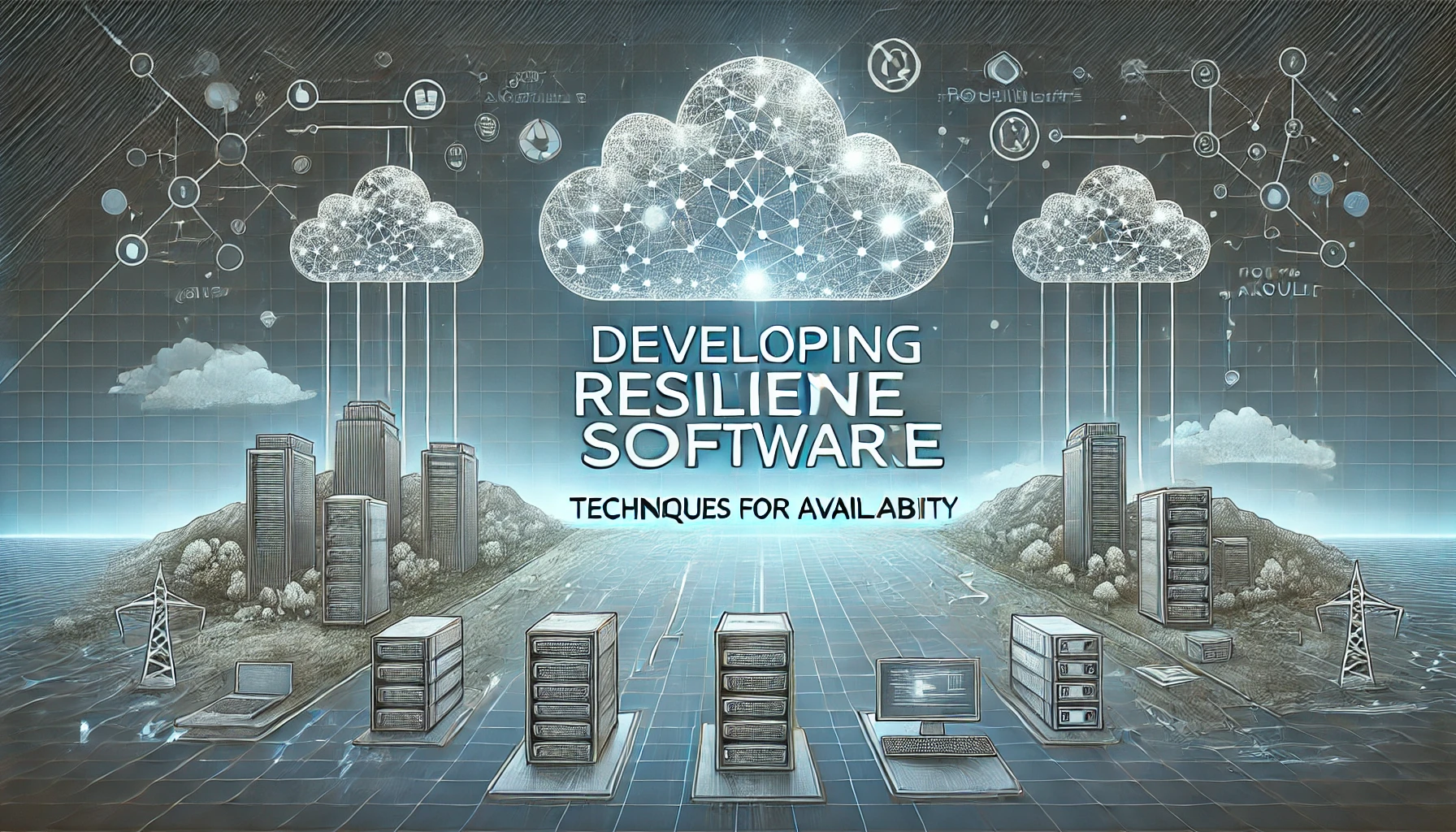Businesses rely mostly on flawless and consistent software in today’s fast-paced digital environment. Should a software program fail or encounter disruptions, the effects could be really serious. Along with lost income, it can sour a companies brand and erode client confidence. Here is where availability and resilience shine. I will provide ideas on creating strong, long-lasting software systems that guarantee the highest uptime.
What Is Software Resilience and Why Does It Matter?
Software resilience is the capacity of a system to carry on operating in the presence of flaws, mistakes, or other unanticipated problems. Resilient software keeps its basic operations even when things go bad, therefore avoiding downtime. Simply said, it’s about creating programs that can manage mistakes without disastrous results.
By comparison, availability is more concerned with end-user accessibility of software. A highly available system ensures that users may access the program or service at any one moment with the least disturbance.
Not only buzzwords, software resilience, and availability are vital for maintaining customer satisfaction high and operations-free. Your companies development will suffer if your software is not available when clients most need it. Considering this, let’s examine the issues that might undermine the resilience and availability of software systems more closely.
Important Obstacles to Reach Software Availability
There are numerous factors that contribute to the availability of software and several hurdles that developers must overcome to keep systems running smoothly.
- Single Points of Failure (SPOF): One of the most common pitfalls in software architecture is having a single point of failure. This happens when a part of your system can go down and bring the entire service to a halt.
- Hardware and Network Failures: Even the best-designed software can face issues when underlying hardware or network components fail. While not directly related to the code, these factors can drastically impact availability.
- Scaling and Load Balancing Issues: As systems grow, they need to handle more traffic. If the system isn’t properly scaled, performance can degrade, leading to downtime or slower responses.
- Software Bugs and Dependencies: Bugs in the software code or dependencies on external services can also impact a system’s availability. These issues can cause the application to crash, freeze, or become unresponsive.
- Human Errors: Mistakes made by operators, developers, or IT teams can also lead to downtime. Software configuration errors, incorrect code deployment, or human-caused disruptions to infrastructure are all risks.
Resilient Software Building Guidelines
To address these challenges, developers must follow principles that guide the creation of resilient software systems. By designing with resilience in mind, we can prevent small issues from turning into major failures.
- Design for Failure: No system is perfect, and failures are inevitable. But how your software reacts to failures can make all the difference. The principle of “fail fast, fail-safe” suggests that when a failure happens, it should happen quickly and be contained. This way, it doesn’t spread or escalate, causing widespread disruption.
- Redundancy and Diversification: Build redundancy into your system. By using multiple servers, data centers, or even cloud providers, we can ensure that if one part of the system fails, others can take over, minimizing downtime. Avoiding a single point of failure and diversifying your architecture is vital for ensuring continued service availability.
- Failover Strategies: Implement failover mechanisms to ensure your software continues to work even if one part of the system breaks down. Automated failovers should detect issues and switch to backup systems without any manual intervention.
- Graceful Degradation: When something goes wrong, software should reduce functionality rather than completely crash. For instance, if a database goes down, the system could still serve static content or some reduced functionality, allowing users to access parts of the system while maintaining availability.
- Continuous Monitoring and Alerts: Proactive monitoring tools should be in place to track system performance and raise alerts when issues arise. With real-time data, developers and operations teams can address problems before they escalate.
Strategies for Enhancement of Resilient Software System Availability
There are several techniques to ensure that your software maintains high availability, even under difficult circumstances. I’ll cover some of the most effective strategies.
Distribution of Traffic and Load Balancing
- Horizontal Scaling vs. Vertical Scaling: Horizontal scaling involves adding more servers to distribute the load, while vertical scaling adds resources (like CPU or memory) to an existing server. Horizontal scaling is typically more effective for handling large volumes of traffic and can prevent system bottlenecks.
- Automated Load Balancers: Use automated load balancers to direct user traffic across multiple servers. By distributing the load evenly, we reduce the chances of overloading any single server.
- Geo-Distribution and Multi-Region Deployments: Deploying applications across multiple geographic regions ensures that if one data center goes down, others can pick up the slack. This technique also helps with minimizing latency for users in different parts of the world.
Redundancy and Replication in Context
- Database Replication: By replicating databases across multiple nodes, we can safeguard data and keep applications running even if a primary database fails. You might choose between a master-slave setup or multi-master replication, depending on the specific needs of the application.
- Data Redundancy Across Regions: Just like with load balancing, having redundant data across multiple regions ensures that your software can continue working, even if one region experiences issues. It provides an additional layer of resilience.
Using Automated Failover Systems
- Active-Passive vs. Active-Active Failover: Active-passive failover involves having a backup server that takes over only when the primary server fails. Active-active failover, on the other hand, has multiple active servers working in parallel, with traffic being distributed among them. Both have their place, but active-active is more suited to applications that need high availability without significant lag.
- Disaster Recovery Plans: Having a well-documented disaster recovery plan is crucial. In case of a complete system failure, a clear set of procedures should be in place to restore services as quickly as possible. Test these procedures periodically to ensure they will work when you need them most.
Microservices Architectural Design for Fault Isolation
- Decoupling Services: Microservices architecture allows you to break your application down into smaller, independent services. This means that if one service goes down, the rest of the application can still function. This isolation of faults is a powerful way to enhance resilience.
- Service Mesh: A service mesh helps manage communication between microservices and ensures that even if one service fails, the others can still communicate and process requests. Tools like Istio or Linkerd are often used for this purpose.
- Containerization and Orchestration: By using containers (such as Docker) and orchestration tools (like Kubernetes), you can manage the deployment, scaling, and operation of your application in a way that minimizes downtime. Kubernetes automatically monitors the health of your containers and can restart any failed instances.
Caching Strategies and Content Delivery Networks (CDNs)
- CDNs for Faster Content Delivery: CDNs cache static content at multiple locations worldwide, improving response time and reducing server load. CDNs also act as a failover mechanism if the origin server goes down.
- Cache Layering: Caching data at different levels of the stack (e.g., application, database, edge) ensures that frequently requested data can be served even if parts of the system are unavailable. This significantly improves both speed and availability.
- Edge Computing: Edge computing can help with resilient data processing at the network’s edge, rather than relying solely on a centralized server. By distributing processing closer to users, systems are less likely to experience latency or downtime due to a single point of failure.
Testing for Resilience: Chaos Engineering and Stress
When building resilient software, it’s essential to go beyond simply hoping your systems will perform well under pressure. Proactive testing is key to ensuring that your slot machine software development functions as expected in real-world conditions, especially during failures. One effective method is Chaos Engineering, where you deliberately introduce faults into your system to observe how it responds.
This approach helps uncover vulnerabilities before they can lead to significant issues, such as downtime. For example, Netflix employs the Simian Army, a set of tools designed to simulate various failures across their network, to test their system’s resilience in a controlled, yet unpredictable environment. Another critical testing practice is Stress Testing and Load Testing, which involves simulating high traffic or extreme conditions to evaluate how your system performs under heavy demand.
These tests help identify potential weak spots that could cause failures during peak usage periods, such as during a product launch or a traffic surge. By running these tests, you can ensure that your system not only works under normal conditions but is also prepared to handle unexpected challenges, ultimately increasing its robustness and reliability.
Monitoring and Constant Improvement
Early identification of problems and quick response to preserve ideal system availability depend on effective monitoring. Being proactive guarantees speedy fixes when issues develop and helps to avoid downtime. From hardware health to Zillow app performance giving live metrics that keep you informed about the state of your system, Prometheus, Grafana, and Datadog are priceless real-time monitoring tools for tracking every element of your infrastructure.
Apart from continuous monitoring, post-incident analyses are essential to increase system dependability. After an incident, a comprehensive post-mortem study helps identify the underlying reason for the failure thereby enabling the application of corrective actions to stop the next events.
Including artificial intelligence and automation in your monitoring plan will also greatly improve effectiveness. While automation allows for speedier responses to some problems, such as auto-scaling or failover, with little human participation, AI-powered systems can identify anomalies and possible failures before they escalate.
These methods taken together with real-time monitoring, post-incident reviews, and AI-driven automation form a complete solution that not only fixes problems fast but also guarantees ongoing improvement, so assuring that your systems remain strong and accessible over the long run.
Conclusion
Although creating strong software systems is not a simple chore, companies depending on ongoing service delivery must do it. Techniques including redundancy, failover, microservices, and proactive testing will help your software availability and performance be much enhanced. Furthermore, disaster recovery strategies and appropriate monitoring tools help you to guarantee that your systems remain functioning even in the presence of unanticipated catastrophes.
Building resilience is about developing a system that can adjust, react, and recover when things go bad not only about avoiding downtime. I advise you to apply these ideas and strategies to your ongoing growth. Make your systems more strong right now to protect your company against future hazards.
Your software projects now have to give availability and resilience top importance. Review your architecture first then use some of the ideas covered on this page. Don’t wait until downtime starts to cause issues; act today to safeguard your systems for tomorrow.








